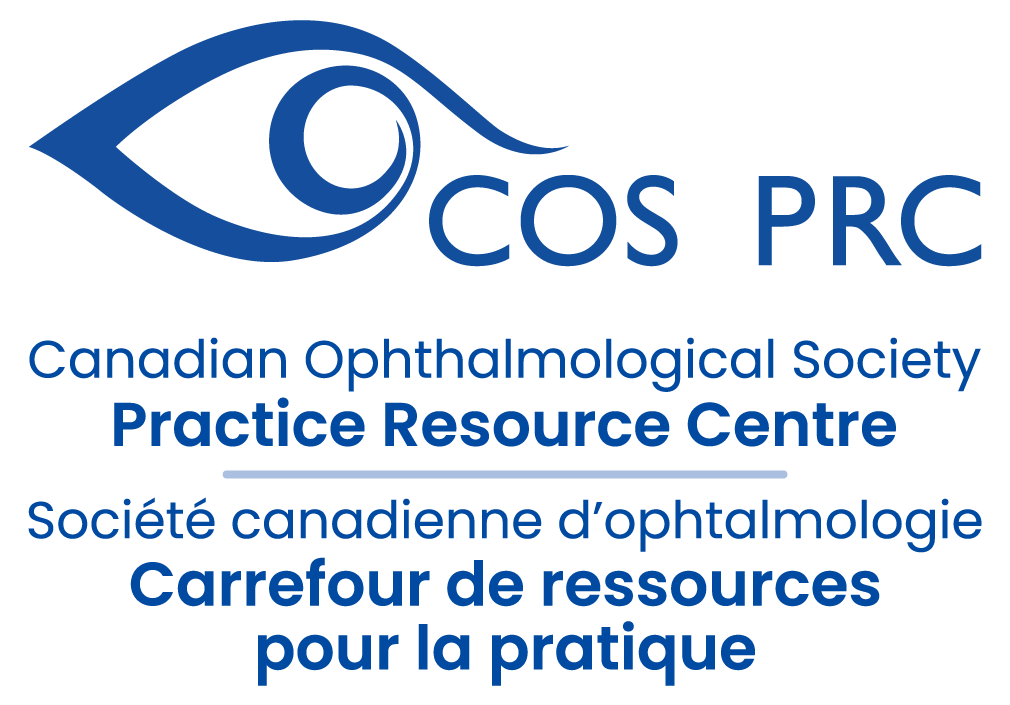Submitted by: Yosra Er-reguyeg

March is Workplace Eye Awareness Month, dedicated to promoting eye health and safety in professional settings. With over 700 work-related eye injuries occurring daily in Canada, protecting vision is a critical aspect of workplace safety. This PRC issue provides an overview of common workplace hazards and protective strategies; as well as a list of national resources to help providers promote workplace eye safety and awareness among patients.
Common Workplace Eye Hazards
- Flying Particles and Debris: metal shavings, wood splinters, dust, and other airborne materials can cause corneal abrasions or penetrate the eye, leading to severe damage.
- Chemical Exposure: industrial and healthcare professionals risk chemical burns from splashes and airborne vapours.
- Radiation Exposure: welders, laboratory workers, and those using high-intensity light sources face ultraviolet (UV) or infrared radiation risks, which can damage ocular tissues.
- Digital Eye Strain: office workers experience Computer Vision Syndrome due to prolonged screen use, leading to dryness, discomfort, and headaches.
- Infectious Disease Exposure: healthcare workers are at risk of eye infections from bloodborne pathogens or airborne contaminants.
Eye Protection Guidelines in Canadian Workplaces
- Usage of Canadian Standards Association (CSA)-certified protective eyewear: all protective eyewear in Canada must meet CSA Z94.3 standards to ensure impact resistance, UV protection, and durability.
- Prevention of digital eye strain in office settings: follow the 20-20-20 rule: every 20 minutes, take a 20-second break and look at something 20 feet away. Optimize your workstation by adjusting screen brightness, ensuring proper lighting, and positioning the monitor at eye level.
- Anticipation of workplace eye injuries: emergency eyewash stations should be easily accessible in workplaces handling chemicals and patients should seek medical evaluation as soon as possible.
Vision Care and Occupational Health Policies in Canada
- Many Canadian employers provide vision care benefits, but only15% of employees report satisfaction with their coverage.
- Occupational Vision Programs across Canada provide prescription safety eyewear to employees in industries requiring eye protection.
- Regular comprehensive eye exams can detect early signs of workplace-related vision issues and are encouraged by the Canadian Ophthalmological Society.
Workplace eye safety is essential for preventing injuries and long-term vision issues. Recognizing Workplace Eye Awareness Month is an opportunity to reinforce best practices and ensure clear vision for a productive workforce.
Resources on workplace eye safety
- CCOHS H&S Report (2014) – Use of CSA-approved eyewear and matching PPE to hazards ( CCOHS: Health and Safety Report – Past Issues ) ( CCOHS: Health and Safety Report – Past Issues ).
- Canada.ca – Protect Your Eyes! – qualities of good protective eyewear and care tips (Protect Your Eyes! – Canada.ca) (Protect Your Eyes! – Canada.ca).
- Canadian Association of Optometrists – reports ~75% of Canadians have digital eye strain symptoms (How Long Does Eye Strain Last? | Cochrane, AB).
- CCOHS – Office Ergonomics: Eye Discomfort – causes of screen-related eyestrain ( CCOHS: Office Ergonomics – Eye Discomfort in the Office ).
- CCOHS H&S Report (2019) – tips to prevent digital eye strain (20-20-20 rule, breaks, ergonomics) ( CCOHS: Health and Safety Report – Past Issues ) ( CCOHS: Health and Safety Report – Past Issues ).
- Benefits Canada (2022) – survey of remote workers’ increased eye issues (As employees’ screen exposure increases, is it time to update vision benefits? | Benefits Canada.com).
- CNIB – “In the Blink of an Eye…Avoiding Eye Injuries” – first aid tips for specks, blows, cuts, chemical splashes (In the blink of an eye … Avoiding eye injuries at work, home and play) (In the blink of an eye … Avoiding eye injuries at work, home and play).
- CCOHS – First Aid for Chemical Exposures – flush eyes ≥15 minutes for chemicals ( CCOHS: First Aid for Chemical Exposures ). CCOHS H&S Report – importance of eyewash stations ( CCOHS: Health and Safety Report – Past Issues ).
- Canadian Association of Optometrists – Best Practices Guide to Vision Benefits (2022) – stats on vision benefit satisfaction and missed work due to vision issues (Best Practices Guide to Vision Care Benefits) (Best Practices Guide to Vision Care Benefits).
- Canadian Ophthalmological Society – press release 2021 – urging regular eye exams (Canadian Ophthalmological Society shares eye-opening stats and tips for healthy vision during Vision Health Month – COS-SCO).
- Eyesafe BC (Doctors of Optometry) – overcoming barriers to PPE compliance with prescription safety eyewear (Eye Injury Statistics: Why Workers Won’t Use Safety Glasses – Eyesafe BC by British Columbia Doctors of Optometry) (Eye Injury Statistics: Why Workers Won’t Use Safety Glasses – Eyesafe BC by British Columbia Doctors of Optometry).



